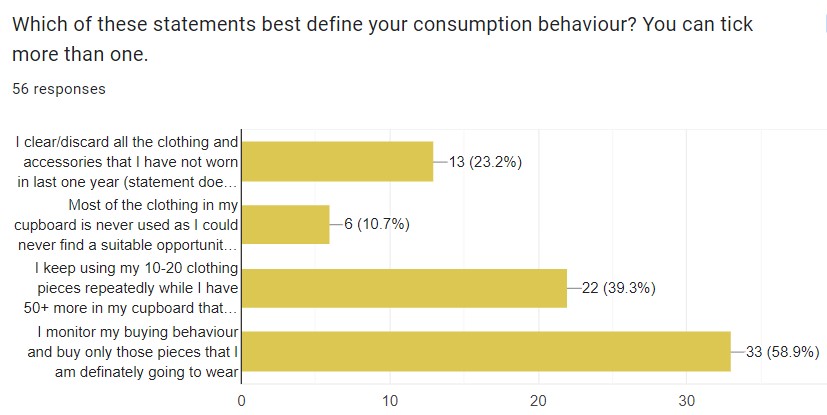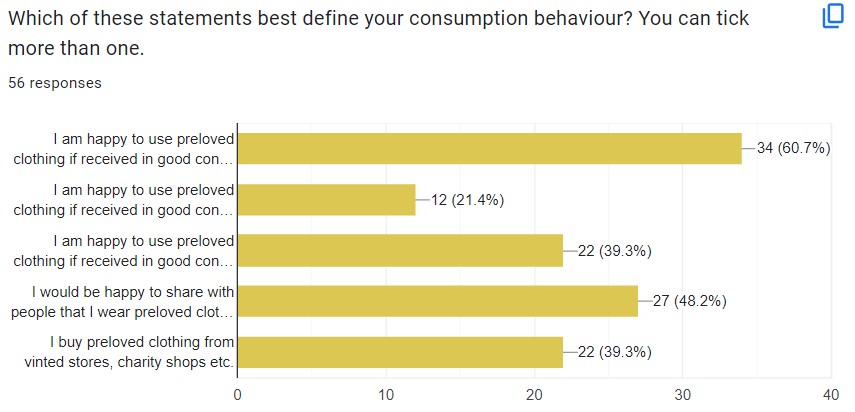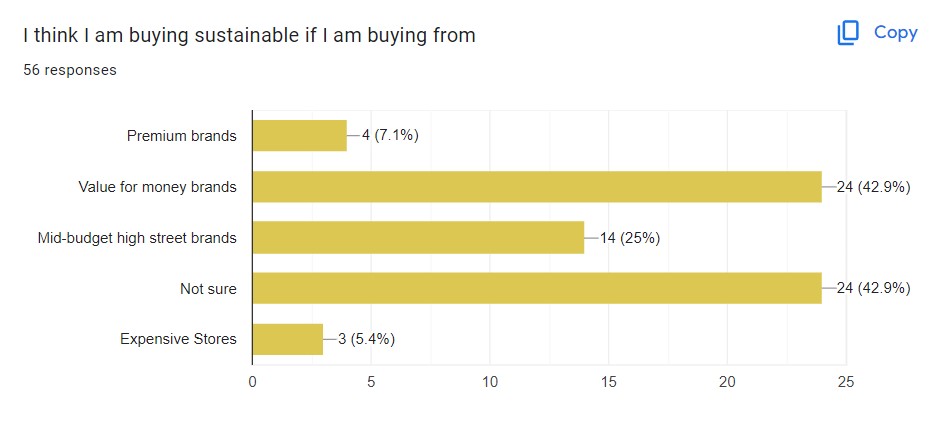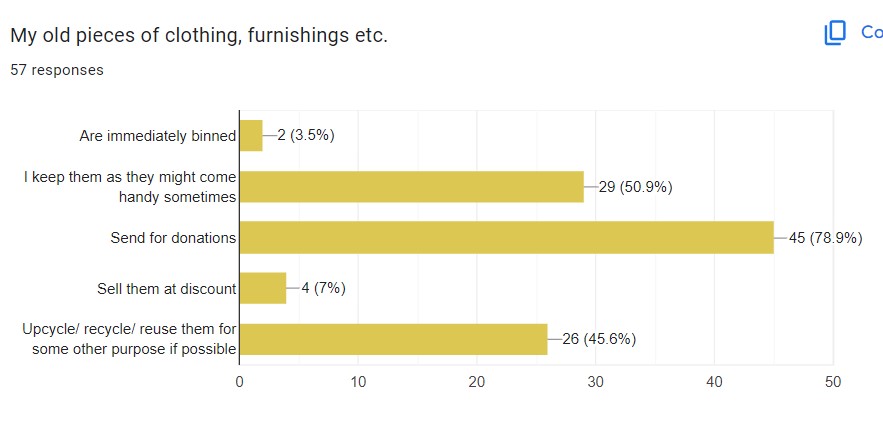Consume OR Sustain OR Consume to Sustain? Can Fashion ever be Sustainable in the true sense?
- omemy tutorials

- Sep 25, 2024
- 12 min read
Updated: Oct 7, 2024
Srishti is a responsible youngster, always keen to do what is right. She wants to do her bit for social and environmental issues caused by unsustainable textile practices. Therefore, she has resorted to buying only from high-end brands. She feels that high cost ensures that all stakeholders in the processing chain (human & otherwise) have received due consideration. However, her friend David disagrees with her. David believes that since he is only buying natural or organic, his textile choices are sustainable; immaterial of the price tag. Another friend Mia finds this whole debate overloaded with wokism. Mia thinks that this debate on sustainable lifestyles can lead to negative attitudes to consumerism. This in turn can trigger a pandemic of hunger, joblessness and unstable economies in some parts of the world, making it more unsustainable for large segments of the population to survive today.
So what exactly is the concept of Sustainability and how does it justify its space in textile industry?
Will concepts of Sustainability always be at loggerheads with economic stability or can there be a middle path?
Can humanity survive in the longer run by struggling to survive today?
To answer these questions, let us first try to understand the phrase, 'Sustainable Textiles'.

What are Sustainable Textiles?
Sustainable textiles are textile products produced in ethically responsible ways. They can also be defined as fabrics and materials produced with minimal environmental impact, considering factors like resource use, pollution, ethics, and social responsibility.
Comprehending the Fundamental Components of Sustainability in Textiles
In recent years, sustainability has transitioned from a buzzword to a significant force shaping the future of consumer products. As consumers become more aware of their environmental impact, the demand for sustainable products has skyrocketed. But what exactly makes a textile product sustainable? Let’s dive into the basic elements that define sustainability in textiles and explore how 'greenwashing' can sometimes be used to mislead consumers.
Sustainable Raw Materials
The journey towards sustainability begins with the raw materials used in manufacturing consumer products. Sustainable sourcing involves choosing materials that have a minimal environmental impact, are renewable, or are recycled. For instance:
Organic fibers: These include cotton, linen, and hemp grown without synthetic fertilizers, pesticides, or genetically modified seeds. These are harvested in a way that does not deplete natural resources or harm ecosystems. Organic farming practices help reduce soil degradation and pollution.
Regenerative fibers: Materials like wool, and alpaca that come from animals raised using regenerative agricultural practices. These practices have the additional benefit of improving soil health and biodiversity.
Recycled and Upcycled Materials: Using recycled or repurposed materials reduces the need for virgin resources and minimizes waste. Textiles made from recycled polyester, nylon, or cotton are widely used in the readymade garment industry. Reusing materials that would otherwise be discarded reduces waste and conserves resources.
Plant-based fibers: Bamboo, lyocell, and other fibers derived from rapidly renewable plants. These are often processed with fewer chemicals compared to traditional textiles.
Fair Trade and Ethical Sourcing: Ensuring that raw materials are sourced under fair trade principles supports the environment and the communities involved in the production process. This could include issues like fair wages, good working conditions, etc.
Misleading Practices of Sustainable Raw Materials Claim
Sustainable textile claims for garments made by 'recycling plastic bottles' often ignore the probability of microplastic pollution and high usage of water and chemicals in the process.
2. Energy & Water Efficiency in Production
Sustainability is also about how products are made. Efficient production processes minimize carbon emissions, reduce water usage, and often result in cost savings. Key practices include:
Use of Renewable Energy: Manufacturing facilities powered by solar, wind, or other renewable energy sources significantly reduce a product's carbon footprint.
Efficient Manufacturing Techniques: Techniques like lean manufacturing, which minimizes waste or uses energy-efficient machinery, can make production processes more sustainable.
Water Conservation: Implementing water-saving technologies and recycling water in production processes reduces the strain on local water resources.
Misleading Practices:
Some companies claim their products are made in “energy-efficient” factories, but they may not disclose the full extent of their energy use or rely on offset schemes without reducing their actual carbon emissions. This practice, often referred to as "greenwashing," gives the illusion of sustainability without substantial action.
3. Sustainable Packaging
Packaging plays a crucial role in the sustainability of consumer products. The goal is to minimize the environmental impact while maintaining product integrity. Using minimal materials for packaging is a simple, direct approach. However, the industry will have to take a step further by ensuring that packaging does not enter the landfill route. Key strategies include:
Minimalist Packaging: Reducing the amount of packaging material used reduces waste and resource use. This includes eliminating unnecessary layers and choosing smaller, more efficient designs.
Eco-Friendly Materials: Utilizing biodegradable, recyclable, or compostable packaging ensures that the packaging has a minimal impact on the environment once discarded.
Reusable Packaging: The B2B textile industry is already experimenting with bulk packaging in bio-degradable plastic boxes that can be reused for various purposes. There is room for innovation and creativity in the B2C space in the textile industry. Retailers can add value to their textile products by packaging them in reusable bags made of jute, linen, etc. These bags can be further used as shopping bags or dress covers.
Exchangeable / Returnable Packaging: Some supermarkets support their customers' efforts towards sustainable living by exchanging their brand's old, worn-out shopping bag for free with a new one. The textile industry can take cues from this practice and adapt it into simple reward systems for customers when they return packaging materials for return and exchange. This would help brands offset EPR (Extended Producer Responsibility) with increased customer stickiness as an added benefit.
Misleading Practices:
Packaging labeled "recyclable" can be deceptive if local recycling programs do not commonly accept the materials. For instance, certain types of plastic are technically recyclable but rarely processed in standard recycling facilities, leading to confusion and increased waste.
4. Product Lifecycle Management
Sustainability in consumer products extends beyond the point of sale. It’s about managing the entire product lifecycle, from production to disposal. This can be achieved through:
Durability and Longevity: Products designed to last longer reduce the need for frequent replacements, lowering overall consumption and waste. Many fast-fashion textile products are discarded because of incorrect sizing, low-quality sewing, and substandard fabrics. While compromising the material and construction quality reduces the cost to a certain extent, these apparel and made-ups usually lose their presentability after the first few washes, ending up in the waste cycle earlier than expected.
Repairability/Adaptability: Products that can be easily repaired rather than discarded contribute to a circular economy, where materials are used for as long as possible. There has been an increasing trend in school uniforms for 'Grow Along' skirts/trousers with adjustable waists and extra folds in the hem to cater to growing children. Your customized tunics/kurtis stitched by traditional tailors would always have 2-3 additional side seams at a cm distance. This ensured that ripping a seam would take a small effort if the wearer added an inch to their measurements. Unfortunately, these practices followed by previous generations were not respected/celebrated and were often discarded as suggestions of poor living.
End-of-Life Considerations: Designing products with their end-of-life in mind ensures that materials can be recovered and reused. There has been an increasing concern about using blended fabrics in apparel as the blended fiber textile waste is hard to recycle mechanically and chemically. In this sense, it can be hypothesized that a 100% polyester fabric/apparel is more sustainable than a cotton-polyester blend. However, 100% polyester or 100% cotton might have other shortcomings (production process) that categorize them as less sustainable.
Misleading Practices:
Nowadays, many apparel and made-ups carry wash-care instructions 'dry-clean only'. While this could be the norm for delicate fabrics like silk or metallic threads, the mass use of this instruction indicates a manufacturer's reluctance to take responsibility for the fabric and stitch quality.
5. Social Responsibility
True sustainability goes beyond environmental impact; it also encompasses social responsibility. Ethical labor practices, fair wages, and safe working conditions are integral to sustainable production. Companies committed to sustainability often:
Support Local Communities: Companies can contribute to social and economic sustainability by sourcing locally or investing in the communities where they operate.
Ensure Fair Labor Practices: This includes paying fair wages, providing safe working conditions, and upholding workers’ rights throughout the supply chain.
Promote Transparency: Providing clear, honest information about sourcing, production processes, and business practices allows consumers to make informed choices.
Misleading Practices:
The term “ethical” is often used without clear backing, making it difficult for consumers to know if a company’s labor practices are genuinely fair. For example, a brand might highlight one fair-trade item while the rest of its products are made under questionable conditions.
6. Consumer Education and Engagement
A sustainable product is only as effective as the consumer's understanding and use. Educating consumers on the benefits of sustainability and how to use and dispose of products properly is crucial. Companies can engage with consumers through:
Transparent Labeling: Clear labels that highlight a product’s sustainable attributes, such as being organic, fair trade, or recyclable, help consumers make informed decisions.
Sustainability Initiatives: Programs encouraging recycling, such as take-back schemes or incentives for choosing sustainable products, foster consumer engagement and participation.
Awareness Campaigns: Educating consumers about the impact of their choices and how to live more sustainably creates a culture of sustainability that extends beyond the product itself.
Misleading Practices:
A brand might launch a “green” campaign or product line that highlights sustainability. Still, if the company’s overall business practices remain unchanged or only a small portion of its products meet sustainable standards, it can mislead consumers about the brand’s overall commitment to sustainability.
Sustainability in textiles is a multifaceted concept involving every stage of a product’s lifecycle, from raw material sourcing to consumer use and disposal. However, consumers need to be aware of how sustainability claims can sometimes be used to mislead. Companies can genuinely reduce their environmental impact by focusing on sustainable sourcing, energy-efficient production, eco-friendly packaging, product lifecycle management, social responsibility, and consumer education. As consumers, understanding these elements—and recognizing when they’re being misused—empowers us to make informed choices, supporting businesses that prioritize real sustainability and fostering a healthier planet for future generations.
Alternative Terminology Associated with Sustainability
In the ever-evolving sustainability landscape, the terminology surrounding this crucial topic continues to expand and diversify. Whether you are a seasoned sustainability enthusiast or just dipping your toes into the green movement, understanding and utilizing alternative sustainability terminology can be enlightening and empowering. This listicle will delve into lesser-known terms that can enrich your conversations and deepen your understanding of sustainable practices. Let's embark on a linguistic exploration to broaden our sustainability lexicon!
1. Circular Economy
The circular economy is a system that minimizes waste and maximizes resources by keeping materials in use for as long as possible through recycling, upcycling, and reusing. It promotes sustainable production and consumption cycles. A circular economy moves away from the traditional "take-make-dispose" model, focusing instead on reusing, repairing, refurbishing, and recycling products.
2. Upcycling / Recycling
3. Carbon Neutrality / Carbon Footprints
Carbon footprint can be defined as the net emission of greenhouse gases during a process. To calculate a product's carbon footprint, the total of all emissions at the time of production, processing, transport, and other activities that make the product available for the customer needs to be added.
Achieving carbon neutrality involves balancing carbon emissions with equivalent carbon removal or offsetting. Companies and individuals can strive for carbon neutrality to mitigate their environmental impact. While efficient processes can minimize carbon emissions, removing them altogether for certain functions is impossible. Organizations can take simple steps to offset the unavoidable carbon footprints through activities like planting and maintaining an equivalent amount of trees.
4. Net Positive
Being net positive goes beyond achieving neutrality by actively contributing more positive impacts to society and the environment than negative ones. It involves creating a regenerative and beneficial influence. Organizations and individuals could calculate their carbon footprints and then make positive environmental efforts that not just stop at carbon neutrality but go beyond the remit of their calculated carbon footprints to leave a positive and not just neutral impact on the environment.
5. Biomimicry / Nature Inspired Design / Eco Design
Biomimicry is an approach that draws inspiration from nature to solve human design challenges. By emulating natural patterns and systems, biomimicry offers sustainable solutions that harmonize with the environment. An interesting example of biomimicry is Bioengineered silk, inspired by spider silk's structure. Pinatex (fabric made of Pineapple leaves) and mushroom leather are emerging as sustainable replacements for animal leather, providing cruelty-free fabric solutions.
6. Ethical Consumerism /Conscious Consumerism / Green Consumer Goods / Slow Fashion
Ethical consumerism involves making purchasing decisions based on ethics and sustainability considerations. It encompasses buying products that align with personal values, such as fair trade, animal welfare, and environmentally friendly practices. Consumers can make informed choices by supporting products and companies that prioritize sustainability, such as using eco-friendly materials, ethical labor practices, or reducing carbon footprints. Slow fashion promotes a more sustainable and ethical approach to clothing production and consumption. It emphasizes quality over quantity, fair wages, and environmentally friendly practices. Brands like Patagonia encourage consumers to buy fewer, higher-quality items that last longer. Their “Worn Wear” program even repairs old products, promoting the reuse of existing goods instead of purchasing new ones frequently.
7. Minimalistic Consumption
Minimalism focuses on purchasing only what is necessary and ensuring that those purchases are thoughtful, durable, and made with sustainable practices in mind. Someone who practices minimalism might buy one high-quality, ethically produced sweater that will last for years rather than multiple cheap, fast-fashion sweaters that wear out quickly.
9. Sharing Economy
The sharing economy reduces consumption by allowing people to swap, share or rent items instead of owning them. This approach maximizes the utility of products and minimizes waste.
Can Sustainability & Consumerism Co-exist?
Sustainable living and consumerism may seem at odds since consumerism often involves excess consumption, while sustainability promotes responsible resource use. However, these two can coexist if consumerism is reimagined in ways that prioritize sustainability.
Sustainable living and consumerism can coexist when consumers and businesses adopt practices that prioritize environmental stewardship, ethical production, and mindful consumption.
It is possible for fashion to be more sustainable, but achieving true sustainability in the full sense is extremely challenging, given the scale and nature of the industry. Truly sustainable fashion must address a wide range of environmental and social impacts across the entire product lifecycle - from raw material sourcing to manufacturing, transportation, retail, consumer use, and end-of-life. Leading brands and innovators are progressing in areas like using recycled materials, implementing renewable energy, and improving transparency. However, scaling these solutions across the entire industry is an enormous challenge.
Sustainability in Fashion / Textiles can only be truly achieved when consumers and businesses work together. Businesses must consistently improve their processes' efficiency and reduce the waste of water, electricity, and materials at every level of the supply chain. At the same time, consumers need to do a fact-check of their own consumption behaviour, identify wasteful practices, and gradually eliminate them.
So, coming back to the original question, CAN FASHION EVER BE SUSTAINABLE IN TRUE SENSE? Depends on our readiness to adapt ourselves and our lifestyles!
How Sustainable is this textile product?
Here's a proposed checklist and scoring system for calculating Sustainability for various textile products. This could be a helpful tool for evaluating the environmental and social impact of different approaches within the fashion industry. Fashion brands, manufacturers, and even consumers could use this checklist to evaluate the sustainability of different textile products, materials, and practices. The goal would be to provide a straightforward framework for quantifying sustainability performance and identifying opportunities for improvement.
How Sustainable are my own textile use practices?
By embracing principles like minimalism, the circular economy, and conscious consumerism, individuals can enjoy the benefits of modern consumerism while contributing to a more sustainable future. There is increasing awareness but lesser clarity about sustainable textile practices, as revealed by a quick, recent survey.
Personal Development through Sustainable Fashion
Beyond just being a trend, conscious fashion represents a personal journey towards self-improvement and growth. By embracing sustainable practices in their wardrobe choices, individuals can align their values with their actions and contribute to a more responsible fashion ecosystem. This shift towards conscious fashion is not just about what we wear but also about the values we uphold and our impact on the world.
Embracing Sustainability One Step at a Time
Transitioning to a more conscious wardrobe may seem daunting at first, but small steps can lead to significant changes over time. Here are some practical tips to help you embark on your conscious fashion journey:
Invest in Quality : Opt for timeless pieces made from sustainable materials that are designed to last.
Support Ethical Brands : Research and support brands that prioritize ethical production practices and transparency.
Upcycle and Repurpose : Get creative with your wardrobe by upcycling old clothes or repurposing them into new styles.
Spread Awareness : Share your journey towards conscious fashion with others and encourage them to join the movement.
As we navigate the evolving landscape of the fashion industry, it is essential to remember that every choice we make has an impact. By embracing conscious fashion and educating ourselves on sustainable practices, we can contribute to a more ethical and environmentally-friendly future for fashion.
.png)

















Thank you for explaining this in simple language. The calculator is very handy and I could test the sustainability score of 10 items in my wardrobe in almost no time.